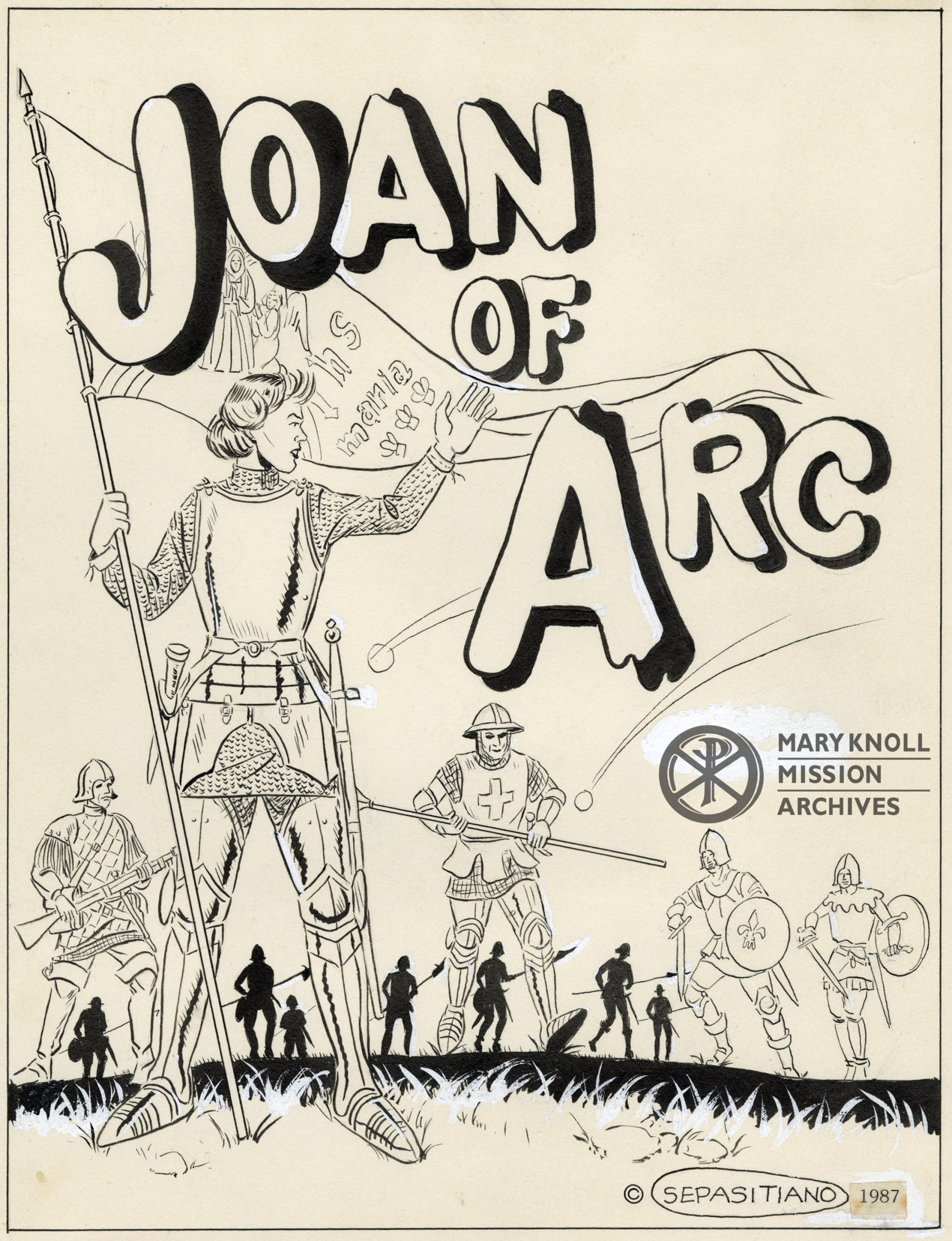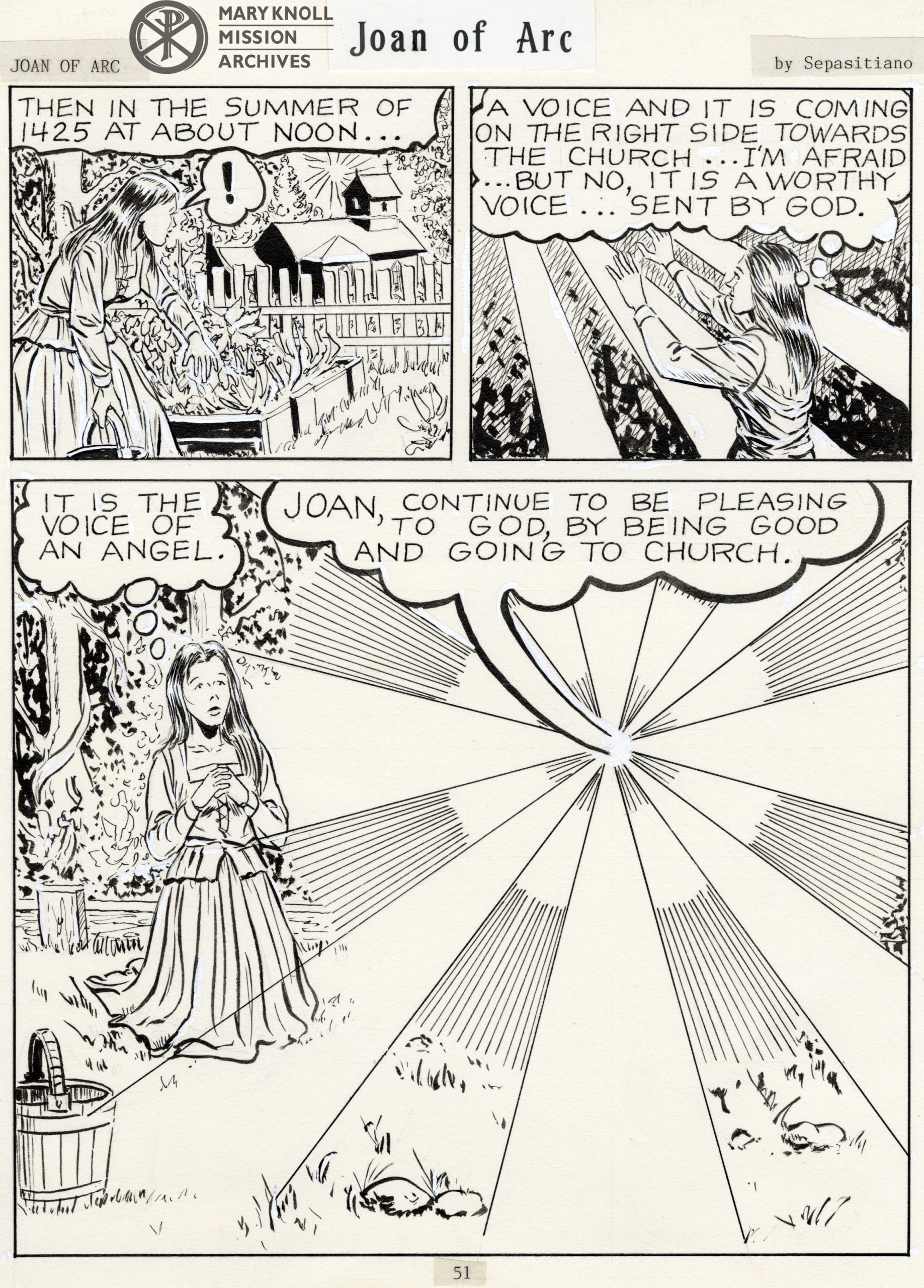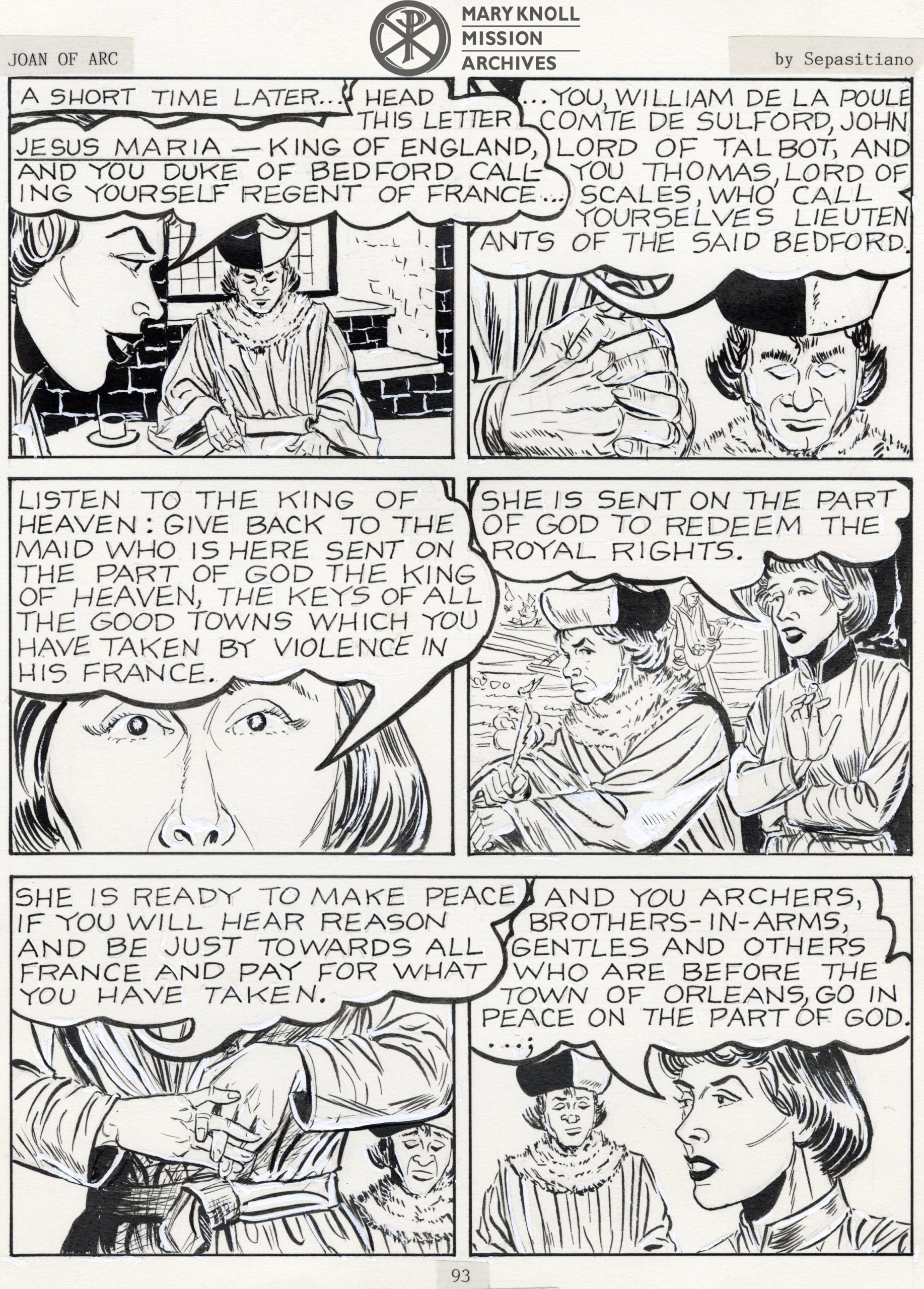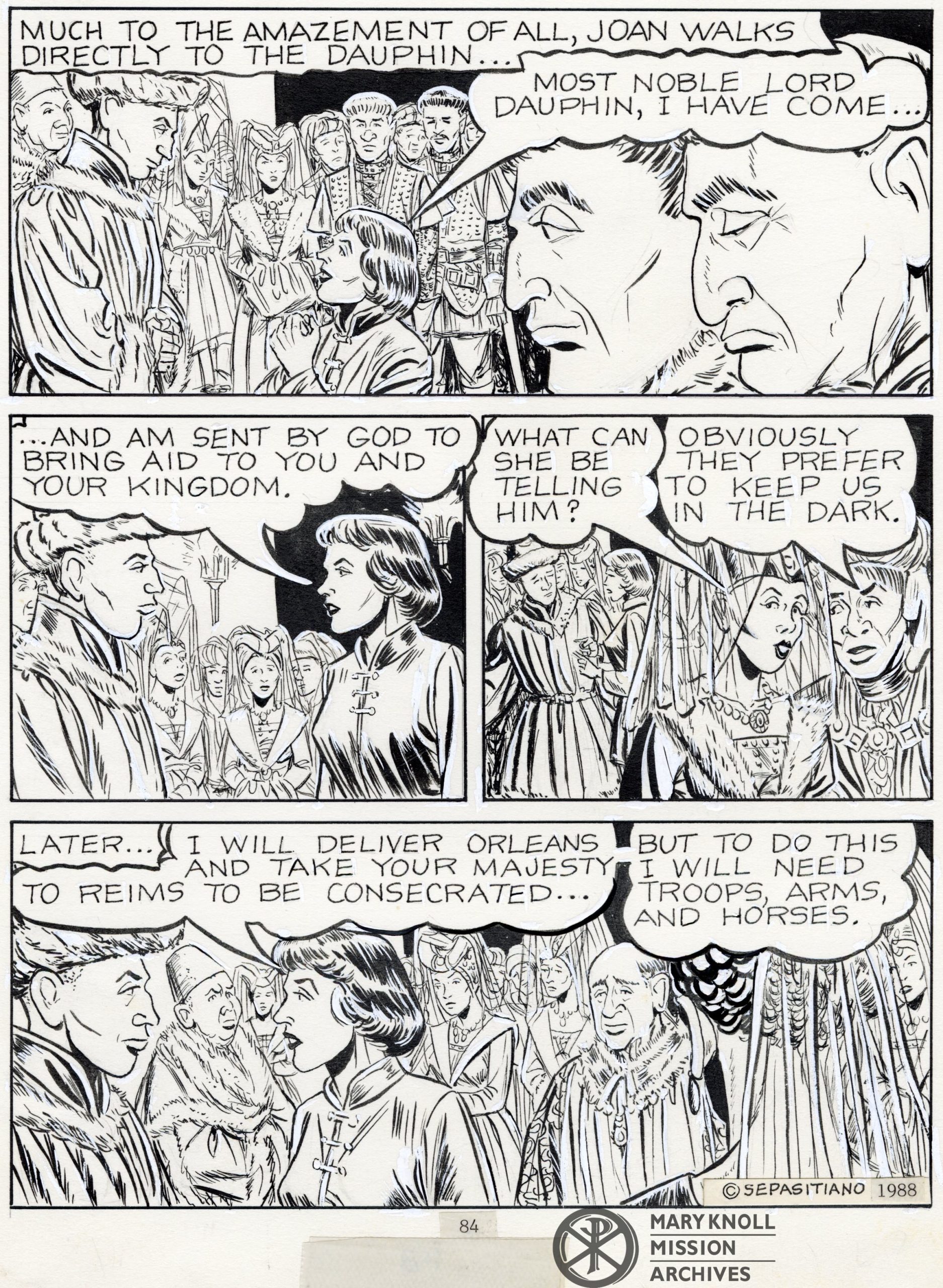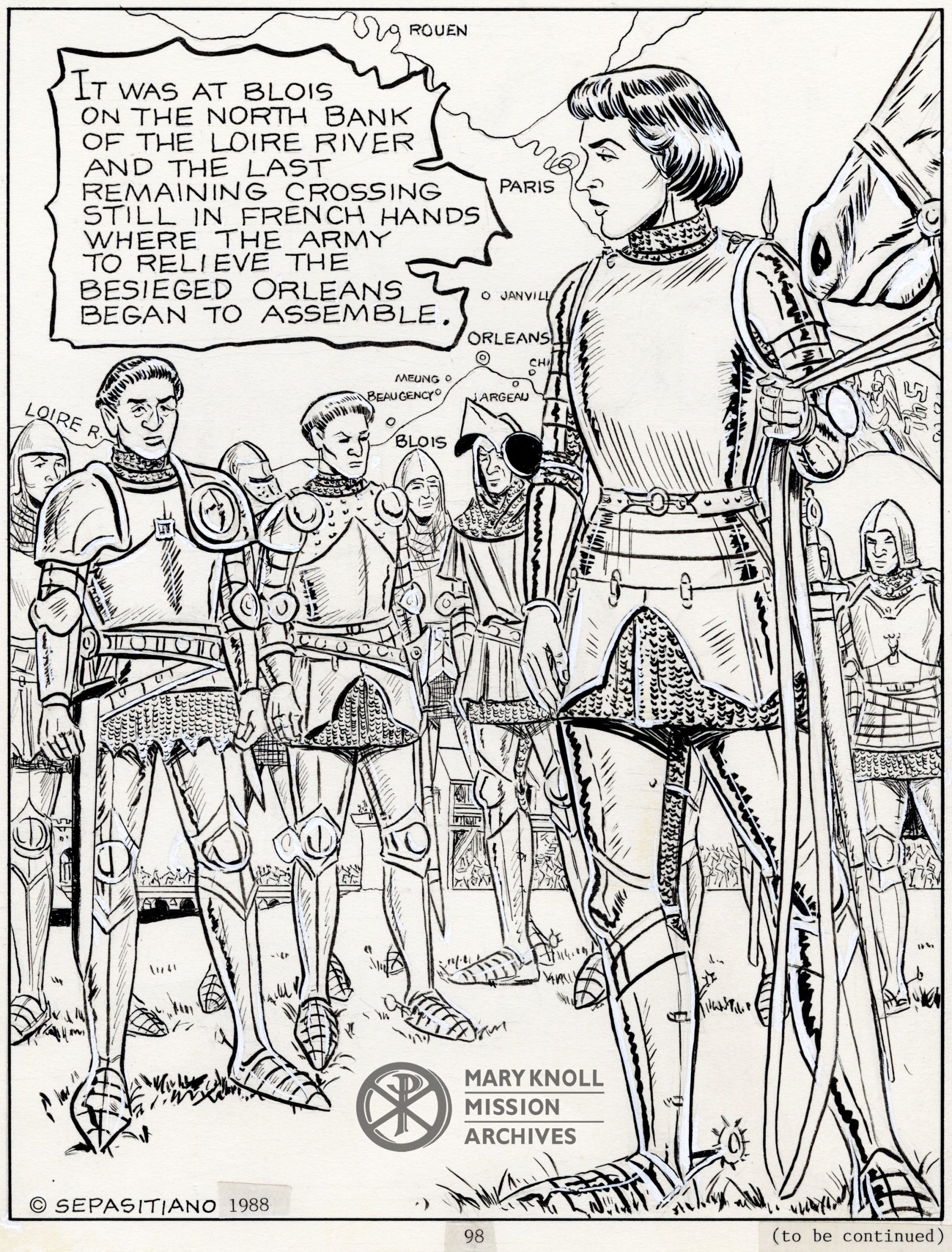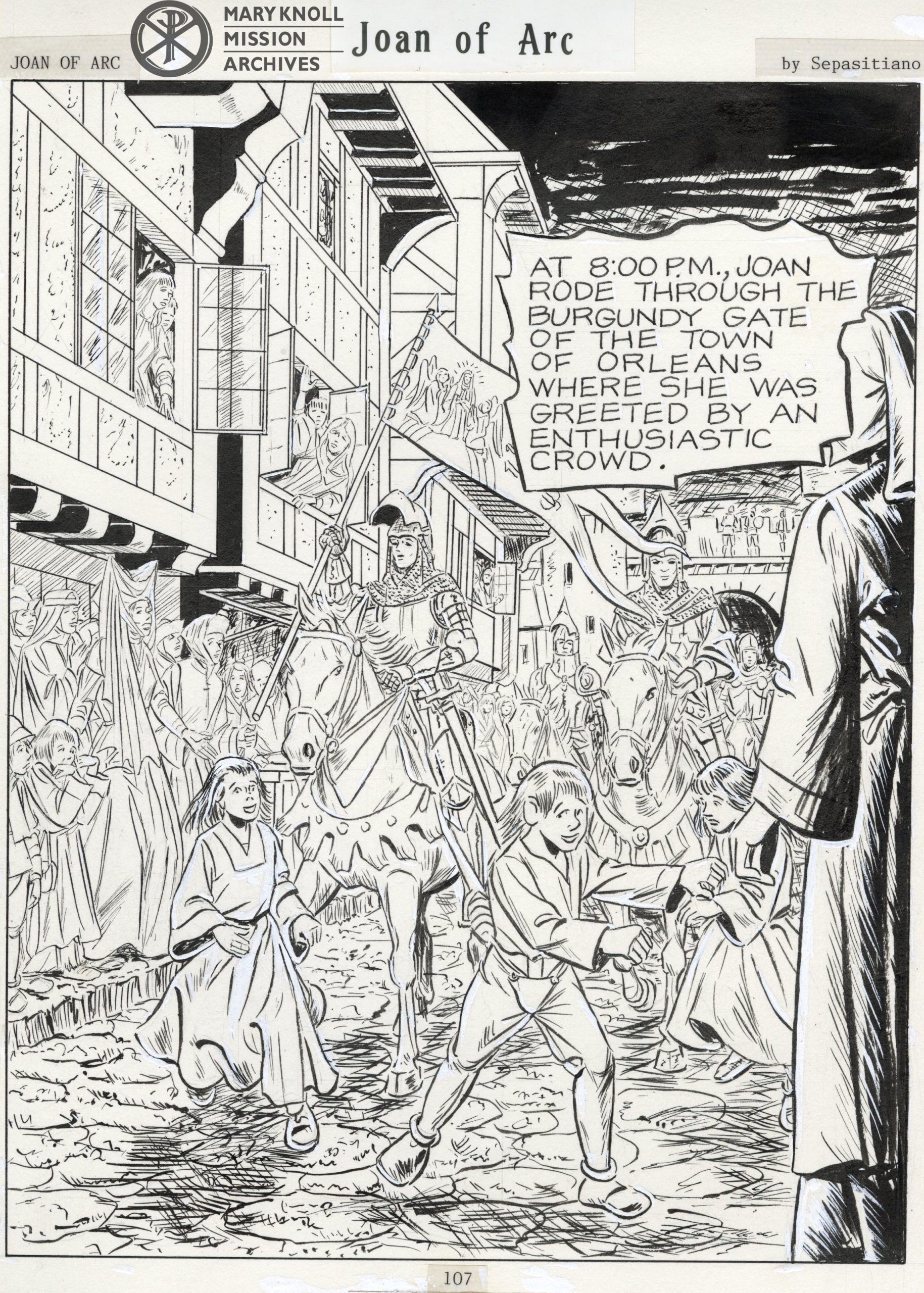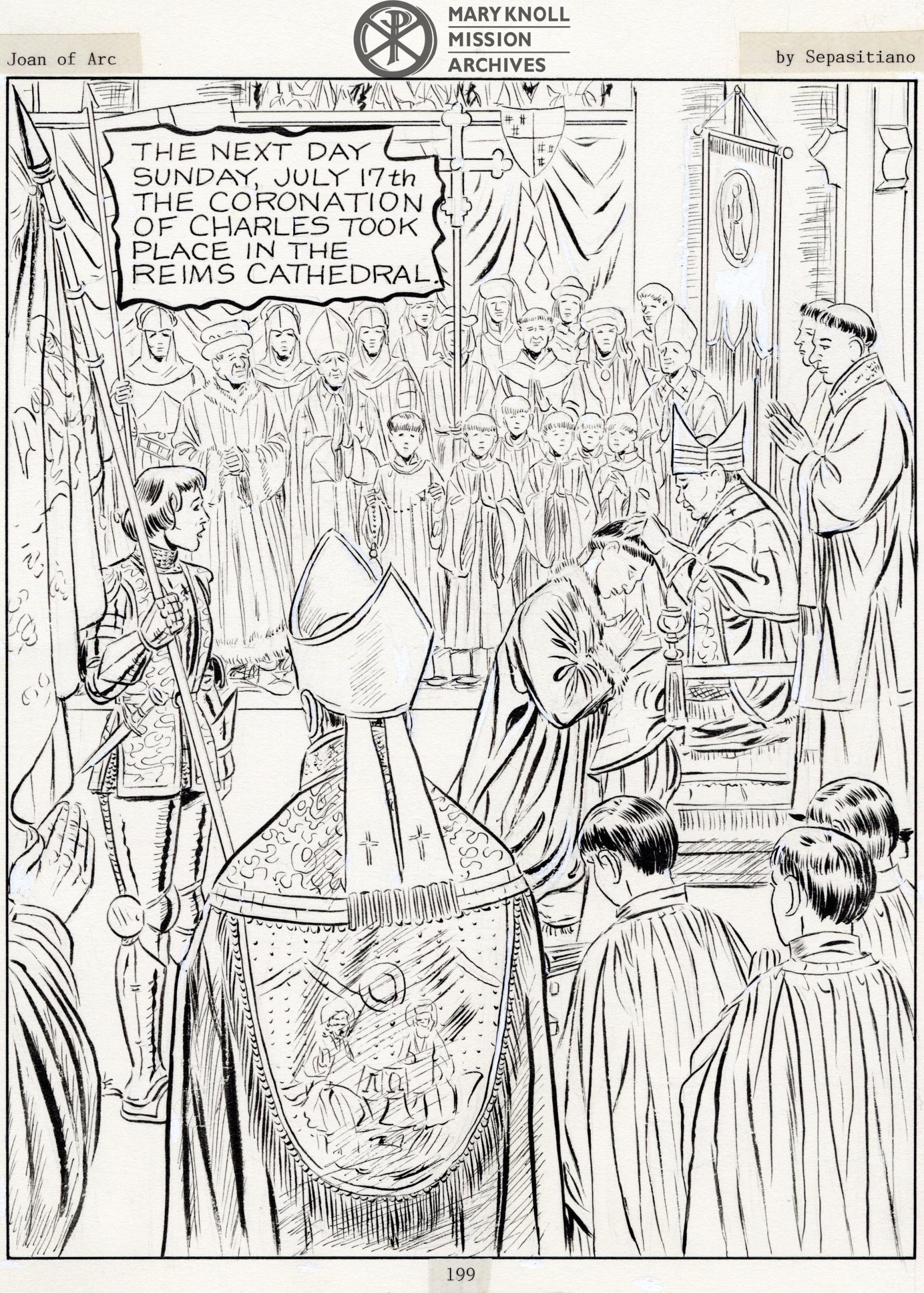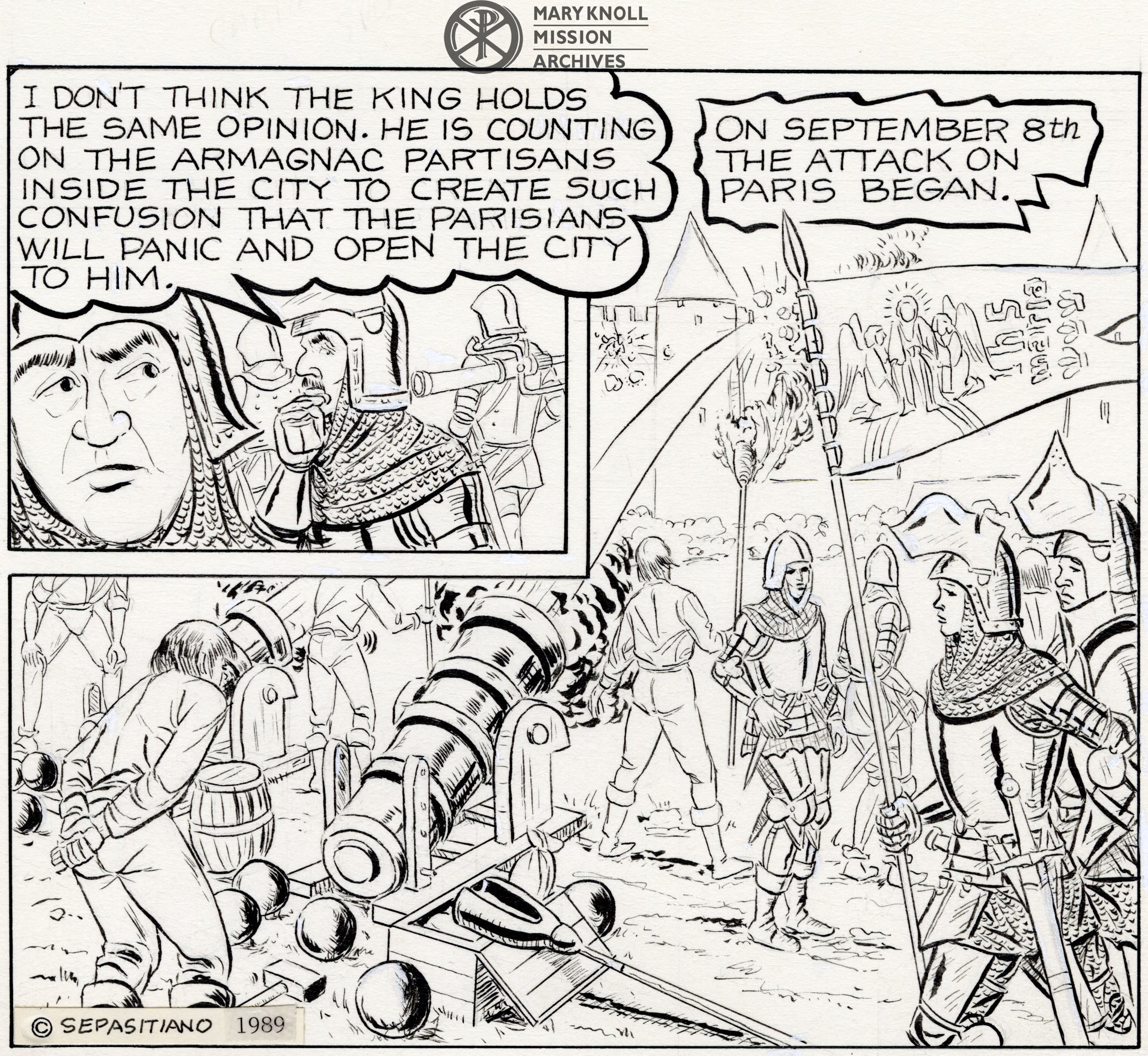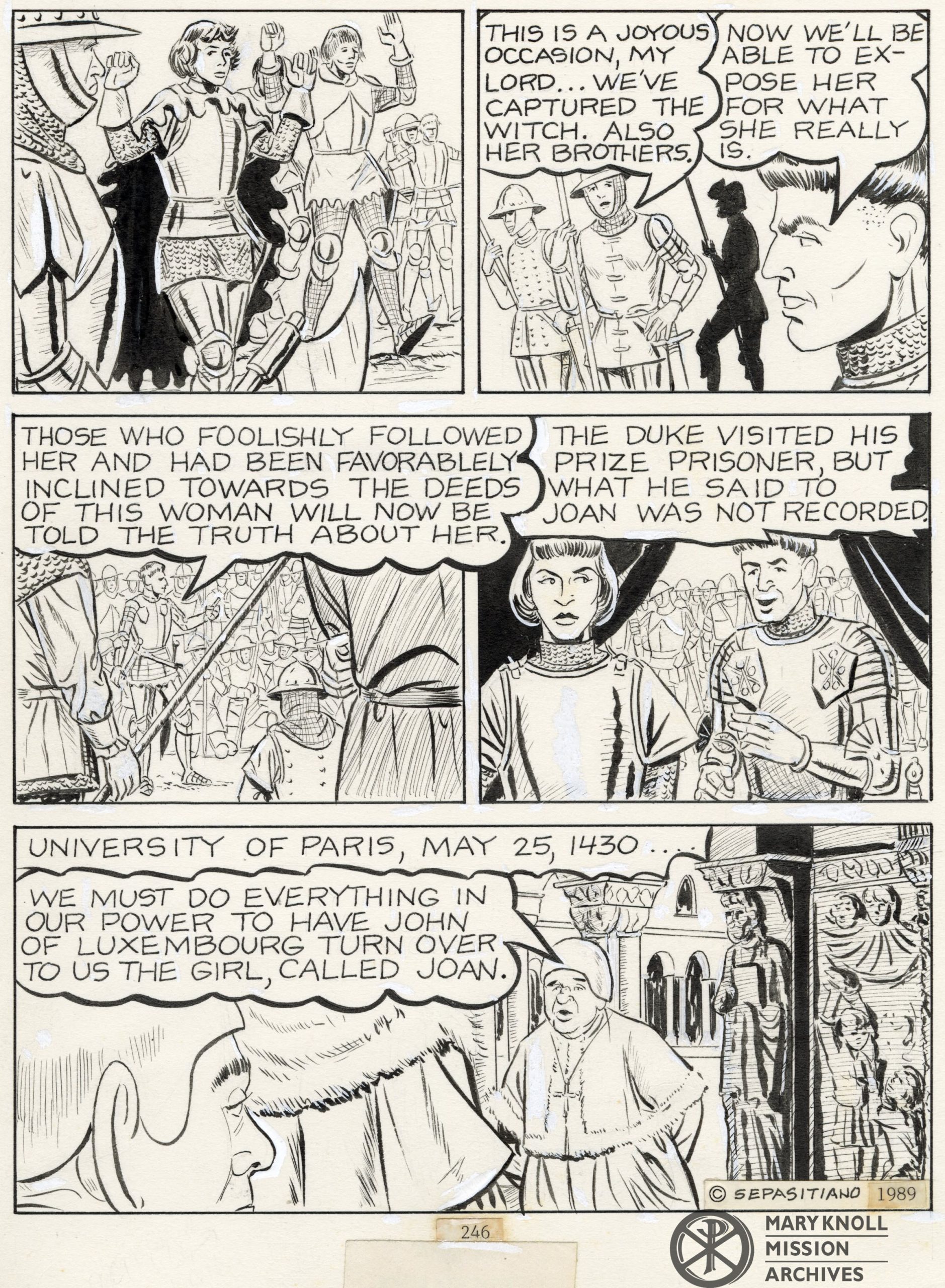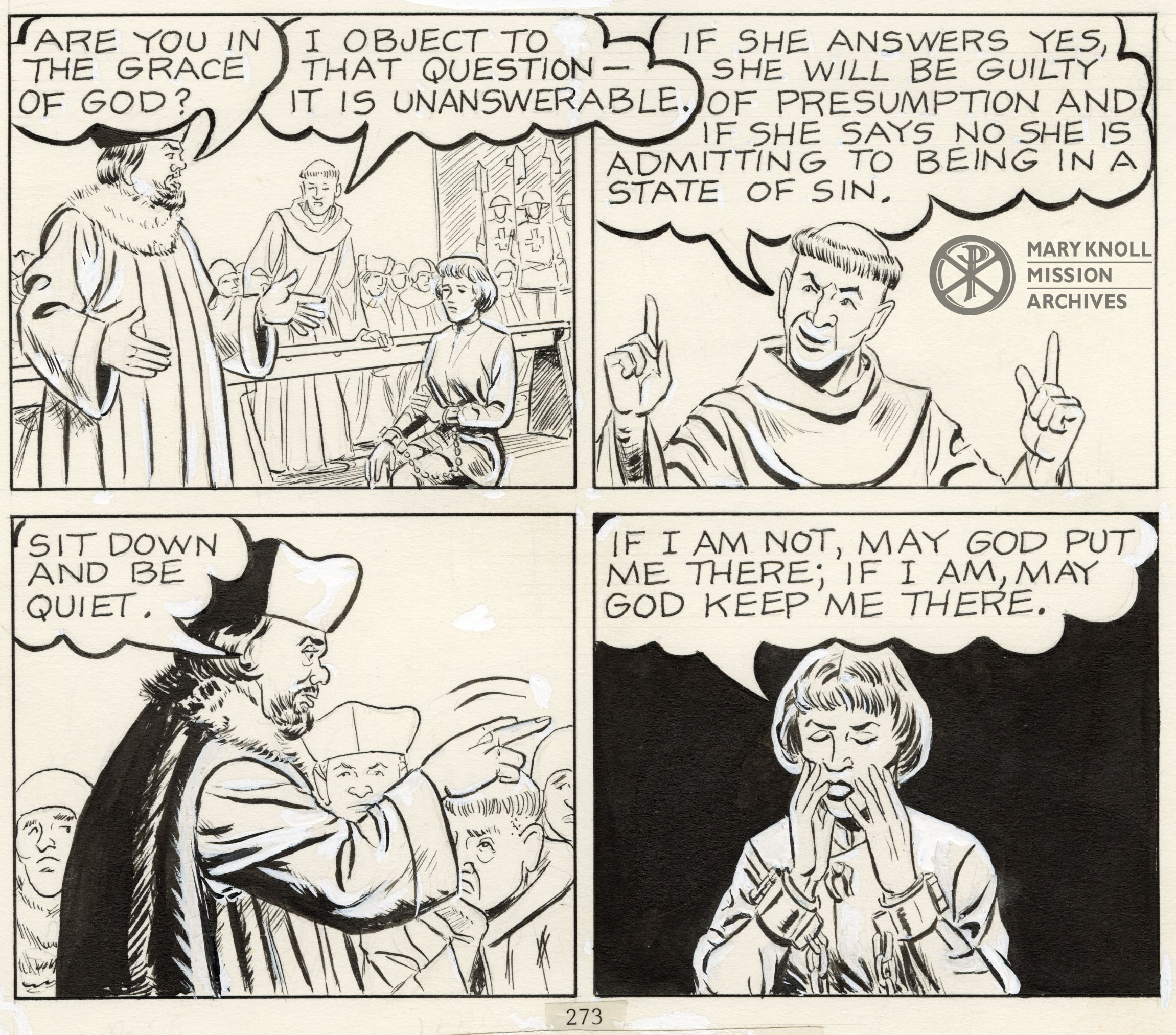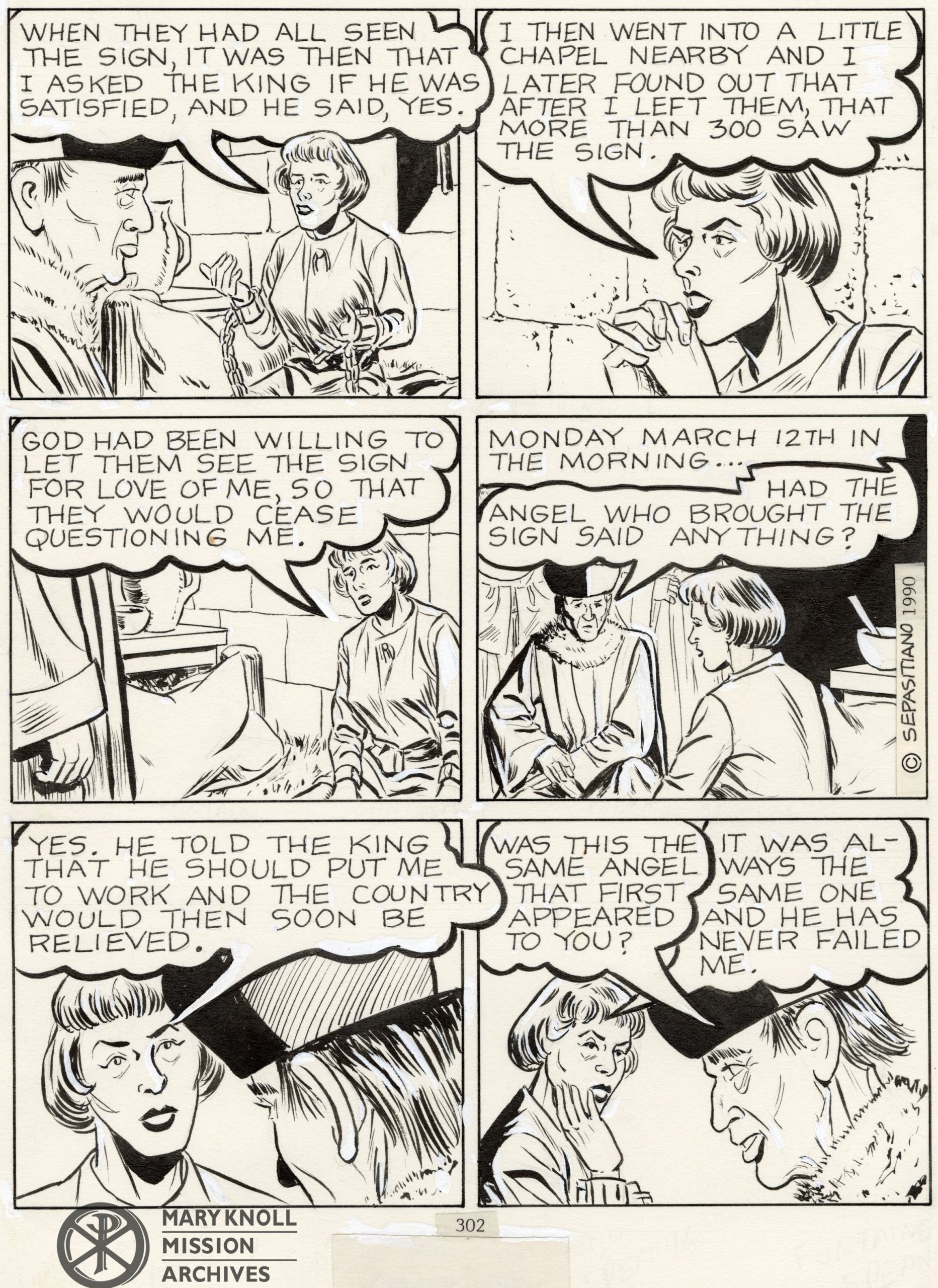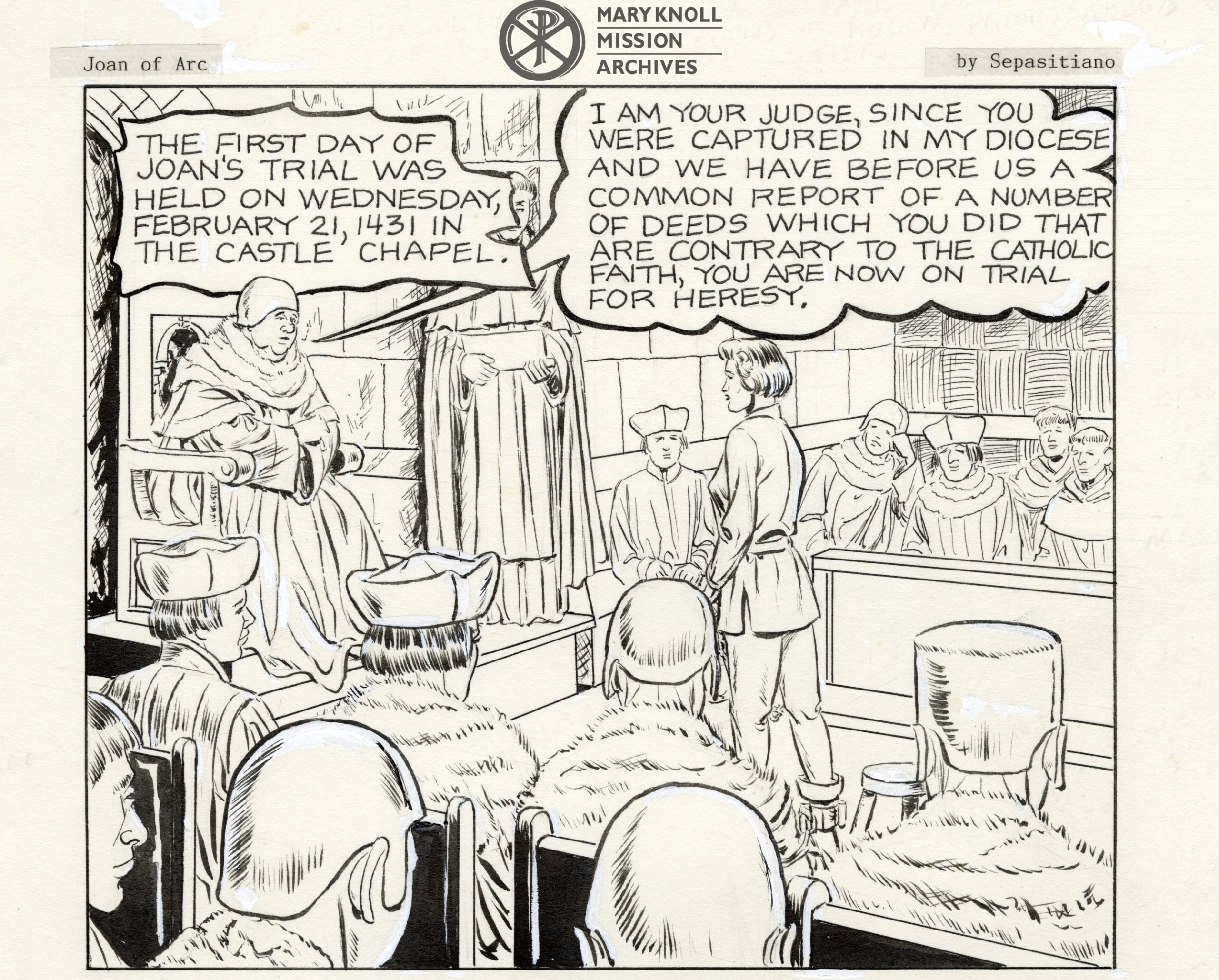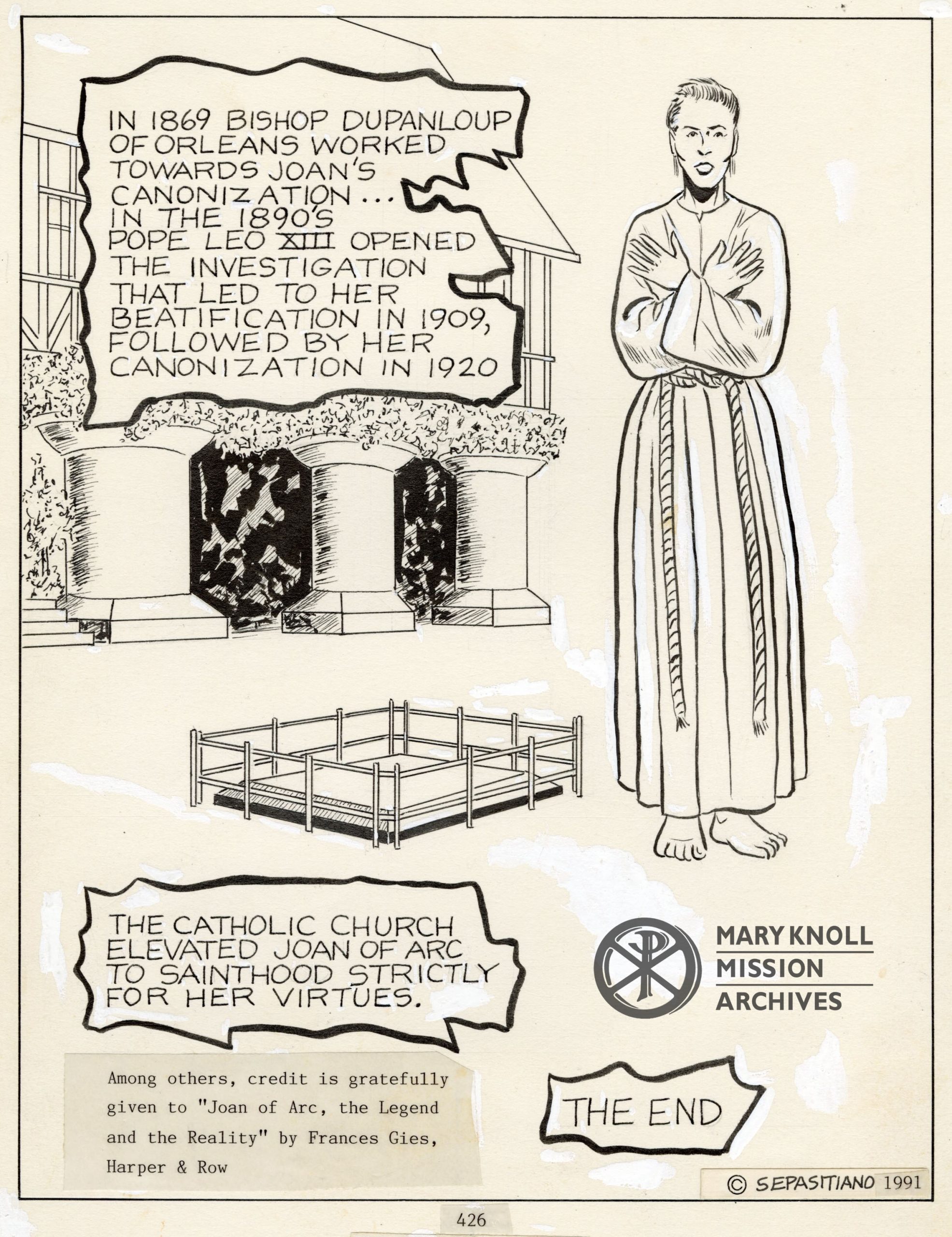On this day in 1431, a nineteen year old girl was brought to the Old Marketplace in Rouen to face her death, branded a heretic for her visions. The girl’s name was Jeanne D’Arc, commonly referred to as La Pucelle, though English speakers will know her as Joan of Arc, The Maid. Joan would later be exonerated for her ‘crimes’, and in 1920 she was made a Saint. Her story has been told many times over the last 592 years, with one iteration coming from one of our Maryknoll Brothers, Brother Sebastian Schwartz.

In my last post about Br. Schwartz (click here to check it out), I looked at Toa: Warrior of the Sunrise from a cultural perspective. We discovered how Br. Schwartz integrated local Samoan culture into his comic about Christian values. This time, I will be using a historical perspective to examine his illustrated biography on Joan of Arc. I will be tapping into my roots as a Historian to compare his biography with the primary sources we have about Joan’s life (Spoiler: It’s pretty accurate). Join me as we discover how Br. Schwartz takes written history and translates it into a visual medium.
But First, A Little Background
Before we dive into the comic itself, let’s explore some of the background first. Br. Schwartz began working on the biography in 1984, while he was still in Mission to Western Samoa. At the time he was working for the Archdiocese of Samoa-Apia and was currently publishing Toa: Warrior of the Sunrise in their Newspaper, Tautai. We do not know exactly why or how Joan of Arc was chosen as the subject, but it most likely came as a request from the Archdiocese. The completed biography consisted of 426 pages and took Br. Schwartz about 5 years to complete. The first issue of the comic was published in 1987 as part of the Tautai newspaper, Volume 14, Issue 10 (May 10-23). The biography was published in each issue as an insert so that all the issues could be combined into one book. The biography finished publishing in 1991, by which time Br. Schwartz had moved on to Mission in Hong Kong.
An Historical Aside
Okay, just one more note before you continue, this time about primary sources. Almost everything we know about Joan of Arc comes from two primary sources: the transcripts from the Trial of Condemnation (1431) and the Trial of Nullification (1455-1456). Both of these transcripts are implicitly biased, and so each should be taken with a grain of salt. The Condemnation Trial (run by her enemies, The English) was clearly slanted to ensure she was condemned with Heresy. There is also some evidence that the language of the transcript was slightly altered at the time to better support a guilty verdict. The Nullification trial is not much better, as it was was sponsored by King Charles VII after his victory over the English. Joan’s vision saw him as the true King of France, so exonerating her would help legitimize his divine right to rule.
Both trials had their own political agenda, and yet they are the only contemporary sources we have of her life. As with most of history, the reality falls somewhere in the middle of both of these documents. To research this for yourself, check out my references for links to the translations and the other sources I used.
History Through Comics
With the background in place and the stage set, Joan finally enters the picture, but not yet the warrior she is known as. Br. Schwartz introduces us to Joan as a young peasant girl trying to survive in a war-torn France. On page 51, she receives her first vision. She is later given her mission to save France from the English, and thus starts her journey. The events as depicted by Br. Schwartz follows what we know about her life, from her pleas at Vaucouleurs to meeting Charles at Chinon, through her numerous military campaigns and her eventual capture in 1430. Br. Schwartz crafts an easy to understand, though a bit fast paced, narrative for Joan’s journey all based on the actual history.
What first piqued my interest in this biography was during a scene set after Charles gives her the mission to relieve Orleans. She is dictating a letter to the Duke of Bedford and the wording seemed familiar. I cross-checked it with a translation of the letter sent by Joan on March 22, 1429, and it was a (mostly) one-to-one translation.
It was at this point I began to cross-check each major event in the biography with the Trial records. I should note that this biography is a linear narrative, while the Trial records generally give information piecemeal and out of order. It took some time, but it seems like every major scene and event depicted lines up with what Joan (and those close to her) said happened during her journey. Br. Schwartz did not skip a major detail or craft an embellishment when adapting her journey to comic book form.
With the stage set, let us at last dive into the illustrated biography of Joan of Arc. Suffice to say, I was impressed by how much of a student of history Br. Schwartz was. The whole biography starts not with Joan’s Birth, but rather the death of King Charles IV of France and the start of the Hundred Years’ War.
In fact, Joan does not even appear until Page 43 of her own biography! Instead, Br. Schwartz uses the first 42 pages to establish the historical background for her story: The history of the Hundred Years’ War and France’s complicated political situation. This is all actually very important set-up for Joan of Arc’s impact on history. It is hard to understand how her actions changed French politics without first understanding the situation in which she enters.
Let’s Talk Art
It would be impossible to discuss a comic book without also examining the artwork. Br. Schwartz’s art is beautiful as usual, but in this biography he took a more realistic approach. Most of the dress, armor, and arms depicted seems period-accurate for the time period. Joan herself has a distinct look that allows you to pick her out in any scene. The rest of the characters usually have a distinct feel to them (when they are named at least), though it can be hard to tell the monks apart.
Br. Schwartz also has a great ability for creating action through his panels. There are very few times the reader will feel like they are reading a book. Br. Schwartz is particularly good at creating variety in the art during conversations, which really save the trial scenes from being monotonous. Between the dynamic nature of the panels and his distinct art style, I don’t think the reader can be bored when reading this biography.
I have put a number of panels from across Joan’s journey in a gallery to the left. Click to expand the images and look through the beautiful artwork of each one.
Recreating A 600 Year Old Trial
The last aspect of this biography I want to touch on is the Trial of Condemnation, which takes about 150 pages (over a third of the biography’s length). The Trial transcripts consist mostly of official letters read out loud, the questions Joan was asked, and her responses. Br. Schwartz leaves out the official letters, which is not a huge loss as most are inconsequential to the heart of the trial. Instead, Br. Schwartz chose to focus on the numerous exchanges between Joan and her inquisitors, though he had to take a few liberties to do so.
In the actual transcripts, the back-and-forths are quick and matter of fact with little explanation behind the questions and her answers. The trial was filled with complex theological issues and Joan was walking on needles throughout. Br. Schwartz added lines here and there that would explain theological concepts and create a more natural conversation between the parties. These additions do not alter the essence of the exchanges, instead allowing them to be followed more easily by the lay person reading the biography. In addition, Br. Schwartz masterfully varies the angles of his artwork to create a more dynamic nature to the conversation, making the exchanges more visually interesting. The heart of the Trial is not changed with Br. Schwartz’s adaptations, but rather made more consumable by the average person.
Final Thoughts
I was both surprised and impressed by how closely Br. Schwartz sticks to the story presented in our primary sources. At times there are one-to-one translations of letters and exchanges, and each major event in her life is covered. As a whole, Br. Schwartz’s Illustrated Biography of Joan of Arc captures the real history of her life and journey from simple Peasant Girl to Hero of France. This adaptation takes words from the page and brings them to life with Br. Schwartz’s beautiful artwork.
Thank you for joining me as I went through another great comic from Br. Sebastian Schwartz. If you would like to see more of his artwork, please check out his other Creative Works here.
References
Joan of Arc’s First Letter to the English. Trans. Allen Williamson (2005). Retrieved from https://archive.joan-of-arc.org/joanofarc_letter_Mar1429.html#nb9.
Joan of Arc: Trial of Condemnation. Trans. W. P. Barrett (1932). Retrieved from https://saint-joan-of-arc.com/trial-condemnation.htm.
Jeanne d’Arc’s Trial of Nullification. From Jeanne d’Arc Maid of Oleans Deliverer of France. Edited by T. Douglas Murray (1902). Retrieved from https://www.jeanne-darc.info/trial-of-nullification/.
Joan of Arc. Retrieved from https://en.wikipedia.org/wiki/Joan_of_Arc.
Br. Sebastian Schwartz Creative Works. Maryknoll Mission Archives. https://maryknollmissionarchives.libraryhost.com/index.php?p=collections/findingaid&id=135&q=schwartz&rootcontentid=92917#id92917.

